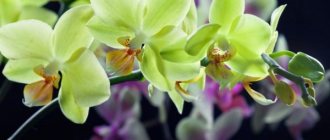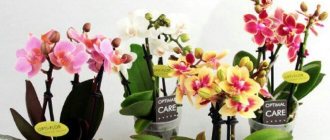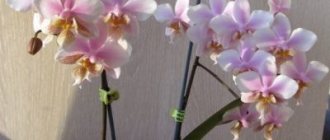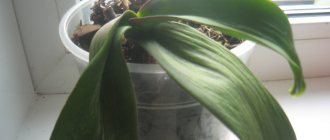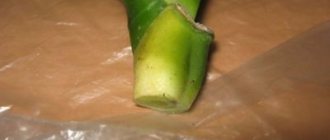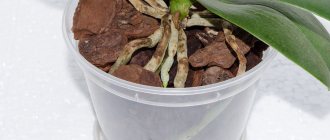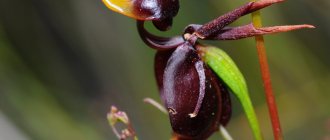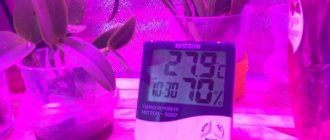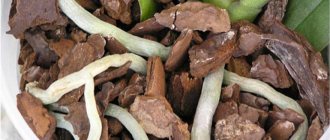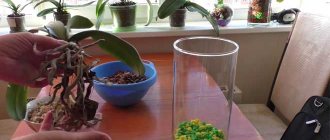Your request has been accepted!
You will receive a notification when the price of the product decreases to the contacts you specified.
Your request has been accepted!
You will receive a notification when the product goes on sale to your contacts.
Phalaenopsis stuartiana is often called the sibling of f. Schiller for the amazing resemblance and origin.
However, it differs from its sibling not only in the size and color of the flowers, but also in many other vegetative characteristics.
It is easy to cultivate and blooms easily , which attracts the attention of collectors and orchid lovers.
F. Pleasant or Amabilis (Phalaenopsis Amabilis)
Growth.
Northern Australia, Indonesia, Papua New Guinea, the Philippines and some islands of the Malay Archipelago.
Biological description.
Stem with 4-5 double-rowed fleshy, shiny leaves of an elongated elliptical shape. The upper side of the leaf blade is dark green, and the lower side is purple. In nature, during a long dry period, leaves sometimes fall off.
In nature, the leaves can reach 50 cm in length. In cultivation, the leaves are smaller - from 15 to 30 cm with a width of 5-10 cm.
F. Amabilis is one of the largest-flowered natural species of the genus: flowers are from 6 to 10 cm in diameter. The peduncle is inclined, up to 80 cm long. The inflorescence is racemose, multi-flowered, up to 50 cm long.
The flowers are 7-10 cm in diameter, and in some forms they are fragrant. The sepals and petals are milky white, the lip is more or less marked with yellow or red.
Flowering in November - February. Flowering duration is 3-4 months.
F. Ambonsky (Phalaenopsis amboinensis)
Growth.
Ambon, Sulawesi, Papua New Guinea and Indonesia.
Description history.
It was described in 1911 from specimens collected in the Moluccas.
Biological description.
There are 3-4 leaves in nature, 4-6 in culture. The leaves are elliptical in shape, 14-25 cm long, up to 10 cm wide.
Peduncle up to 45 cm, sometimes the orchid produces 2-3 peduncles. “Revolving” type of flowering , when one flower fades, the peduncle lengthens somewhat and a new bud appears.
All flower segments are cream, yellow or yellow-greenish, sometimes tinted orange, with brown-red transverse strokes. Flower diameter up to 6.5 cm.
Many clones have a pleasant aroma.
Sepals are elliptical in shape, with curved tips. Petals of similar shape, somewhat shorter. The lip is triple, about 2.2 cm long, the lateral parts are straight, yellow, the front part is white-green, elliptical-oval.
It can bloom at any time of the year, more abundantly in summer.
F. deer-horned (Phalaenopsis Cornu-Cervi)
Growth.
Burma, India (Northeast), Nicobar Islands, Indonesia (Sumatra, Java, Kalimantan), Laos, Malaysia (Sabah, Sarawak), Philippines (Palawan), Thailand, Vietnam.
Biological description.
The stem is up to 5 cm long, hidden by the bases of 4-6 leaves. The leaves are green, up to 22 cm long and about 3-4 cm wide, light green in color.
The peduncle is long-lived, flattened, decorated on the sides with protruding bracts, 20-45 cm long, light green in color, slightly widens at the end and resembles the shape of a horn. Bears up to 12 flowers.
The flowers are 2.5-4 cm in diameter, fragrant, dense, yellow-green with red-brown transverse stripes. The variability of flower color throughout the range is very significant.
Flowering season May-August.
F. Konsky (Phalaenopsis Equestris)
Growth.
Philippines, Taiwan, Borneo. On tree trunks and branches in tropical rainforests at altitudes up to 300 meters above sea level.
Description history.
First described by Schauer in 1843 under the name Stauroglottis equestris. The plants were brought from the island of Luzon and belonged to Mr. Meyen.
In 1848, John Lindley re-described Phal on plants from the collection of Thomas Lobb, a worker. equestris, giving them the name Phalaenopsis rosea. In 1949 Phal. equestris got its real name.
Biological description.
Miniature monopodial epiphyte. The stem is shortened, completely hidden by the bases of the leaves. The roots are fleshy and smooth.
The leaves are dark green, oval or oblong, 10-20 cm long, 5-6 cm wide.
The peduncle appears in the axil of the lower leaves, up to 30 cm long, multi-flowered, racemose or paniculate. Continues growth after flowering begins. Easily forms “babies”.
Flowers are 1.5-3.5 cm in diameter, from white-pink to lilac. Flower color varies greatly.
There are two flowering peaks - spring and autumn, but can bloom at any time of the year.
F. Gigantea (Phalaenopsis Gigantea)
Growth.
Borneo.
It grows high in the canopy of tropical forests at altitudes from 0 to 400 meters above sea level.
Description history.
Phalaenopsis giant was first discovered in 1897 by the botanist Nyvenhuis.
Having identified the plant as Phalaenopsis amabilis, Nyvenhuis took it to the botanical garden of the city of Buitensorg (new name Bogor).
The plant bloomed only in 1909 and was described by the director of the botanical garden, J. Smith. Shortly after the description, the only specimen of Phal. gigantea died.
Only in 1937, during the construction of a road, a second specimen of a giant phalaenopsis with leaves 90 cm long and 40 cm wide was discovered.
Phalaenopsis got its name because of its huge leaves, exceeding 60 cm in length. It is the largest representative of the Phalaenopsis genus.
Biological description.
The stem is shortened, completely hidden by the bases of the leaves. The roots are fleshy and smooth. The leaves are very wide, drooping, leathery, shiny on both sides, rounded, up to 1 meter long, up to 40 cm wide. The total number of leaves is from 2 to 7.
The peduncle is hanging, curved, sometimes branching, thin, can exceed 40 cm in length, bears 10-30 flowers.
The flowers are fleshy, 3.75-7 cm in diameter, with a faint citrus aroma, round in shape, with equal petals and sepals, cream to yellow and greenish-yellow in color, mottled with raised reddish-brown spots or streaks. Flowers have many variations in color details.
F. Hieroglyphic (Phalaenopsis Hieroglyphica)
Growth.
Islands of Palawan, Luzon, Mindanao and Polillo (Philippines).
Description history.
Introduced into cultivation in Europe in 1887 by Dr. Lowe, to whom Dr. Boxall sent several specimens of plants as a gift. The taxonomy of this species was finally determined in 1969.
It got its name due to the similarity of the pattern on the petals with hieroglyphs.
Biological description.
The trunk is shortened, completely covered with the bases of 2-8 leaves.
The leaves are green, shiny, up to 25-30 cm long, 5-9 cm wide.
Peduncle up to 30 cm long, 3-8 flowered, can branch. Undamaged flower stalks can bloom again.
The flowers open almost simultaneously, 3-4 on each branch of the peduncle. They do not fade for about a month. The flowers are dense, waxy, creamy white with numerous lemon-yellow dots or streaks forming a complex pattern, 5-8 cm in diameter. They have a pleasant aroma. Different clones have different odor intensities.
In nature it blooms in summer and autumn. Peduncles easily form babies. The tepals do not fall off after pollination, change color to green and begin to participate in photosynthesis.
Diseases and pests
Small parasite on a leaf blade
Improper care of phalaenopsis during the growing season entails a lot of problems. The flower may become diseased, or insects may appear on it.
Mealybug
Mealybug
Mealybug
A small parasite that infects all indoor plants and feeds on their sap. As a result of vital activity, the leaves turn yellow and disappear. For treatment, you can use laundry soap, which is whipped into foam and applied to the foliage. After 30 minutes, the foam must be removed and the plant washed with a clean cloth.
Thrips
The result of the life activity of thrips
Thrips
Insects damage leaves and flowers. You can tell that thrips have appeared by the brown, chaotically scattered spots. They subsequently turn yellow. The appearance of the leaf plate becomes inconspicuous. To combat this, you can use the following drugs: “Actellik”, “Hostavik”, “Fitoverm”. The latter is less toxic.
Spider mite
Spider mite - an insidious pest of orchids
Spider mite
When the air is too dry, spider mites will certainly appear. Its appearance is indicated by a silver web that wraps around the stems of the plant.
In addition, if your orchid begins to turn yellow in indoor conditions, the flowers quickly wither, and the leaves fall off, it is necessary to urgently inspect the plant and begin treatment.
For mild damage, a soap solution will help. But in case of mass infection, you cannot do without special drugs. The treatment must be carried out 3 times with an interval of 7 days, diluting the purchased drug according to the instructions.
You should know that spider mites carry viral diseases.
Shields
Small parasites in a protective “shell”
Shields
No less nasty creatures that are not so easy to get rid of. The fact is that their body is covered with a chitinous covering, through which chemicals do not penetrate.
And these creatures are alive and well! To get rid of scale insects, you will first have to treat the phalaenopsis with a foam of laundry soap, then rinse, dry the plant and spray it with water in which a few drops of sewing machine oil are dissolved.
Only this method gives 100% results. The fact is that when sprayed, a film is created on the stems and leaves, to which scale insects cannot attach.
Growing phalaenopsis does not cause difficulties, which cannot be said about other types of orchids
It is important to follow the rules of care, this is the only way to achieve gorgeous flowering. With good care, phalaenopsis will delight the eye 2 times a year, and flowering will last for at least 3 months
The video below discusses 4 methods of propagating phalaenopsis.
ORCHID. ORCHID REPRODUCTION: 4 WAYS
Phalaenopsis orchid at home: care after purchase, cultivation, propagation rules | (110+ Photos and Videos)
Projects of country houses for 6-10 acres: 120 photos, description and requirements | The most interesting ideas
F. Lueddemanniana (Phalaenopsis Lueddemanniana)
Growth.
Philippines.
Epiphyte on branches and trunks of trees in tropical rainforests at altitudes from 0 to 100 meters above sea level.
Description history.
Named in honor of the French breeder F. Luddeman, who obtained the first flowering of this species in cultivation in 1865.
It was first introduced into cultivation by the horticultural farm Lowe and Co. in 1864, whose owner, E. Clapton, mistook the plant for Phalaenopsis equestris.
Biological description.
Monopodial epiphyte of medium size. The stem is shortened, completely hidden by leaves.
The root system is well developed, the roots are smooth, long, branching.
Leaves 5-8. The leaves are oval, oblong, paired, hard, 10–25 cm long, 5–10 cm wide.
Peduncle up to 35 cm long, appears from the base of the stem, drooping, bears 2-7 flowers at a time.
The flowers are 4.5-6 cm in diameter, have a pleasant strong aroma, are waxy, white in color with beautiful transverse violet-purple or chestnut lines at the bottom, and with brown tips. The lip is white with a purple coating and bright yellow markings.
The flowers are highly variable in the details of color and shape of individual parts. They open alternately over a long period of time, each flower lasts 25-30 days.
Flowering season: from spring to early autumn.
Links
- [www.orchidspecies.com/phalstuartiana.htm Stuart's Phalaenopsis
species sketch on the Internet Orchid Species Photo Encyclopedia] (English) - [www.phals.net/stuartiana/index.html Phalaenopsis Stuart
, photographs of the species and primary hybrids] (French) - [pagesperso-orange.fr/bernard.lagrelle/Stuartiana/anglais/Phalaenopsis%20stuartiana%20anglais.htm Stuart's Phalaenopsis
species sketch on the Especes de Phalaenopsis website] (English) - [epic.kew.org/searchepic/summaryquery.do?searchAll=true&scientificName=Phalaenopsis+stuartiana Stuart's Phalaenopsis
on the website Electronic Plant Information Center of Royal Botanic Gardens, Kew] (English) - [www.tropicos.org/name/50020869 Stewart's Phalaenopsis
at Tropicos.org. Missouri Botanical Garden.] (English)
F. Parishii (Phalaenopsis Parishii)
Growth.
Eastern Himalayas - Myanmar, Assam India, Thailand and Vietnam.
Description history.
Discovered in Myanmar in 1864 by Reverend Father Samuel Parish, who served as rector of the local church and was an avid orchid lover.
Parish sent the found specimens to Messer Law's company at Kew Botanical Gardens. In 1865, a description of the plant compiled by Heinrich Gustav Reichenbach appeared in the Botanical Newspaper.
Biological description.
Miniature monopodial deciduous epiphyte. The root system is well developed, the roots are flat, smooth, branching. The stem is short, completely covered with leaves. There are 1-3 leaves, they are succulent, paired, dark green, elongated oval, 5-17 cm long, about 5 cm wide.
The peduncle is short, usually does not exceed the length of the leaves, erect or oblique, flat, 5-14 cm long, appears from the base of the stem, bears 4-10 flowers. There may be several flower stalks.
The flowers are fragrant (fruity-candy smell during the day), long-lived, about 2 cm in diameter, bloom simultaneously, last 15-20 days. The flowers are milky white with a very wide lip.
The middle lobe of the lip is purple or purple-lilac, the semicircular plate in its center along the edge is fringed or with long cilia.
The flowering season in nature is spring.
A closely related species is Phalaenopsis gibbosa.
Literature
- Borgato T, 1997, Phalaenopsis stuartiana Reichenbach f. 1881 Gardener's Chronicle ns 16: 748, 1881. Orchis no.119. 13-14
- Camard J, 1983, Les Phalaenopsis. Orchidophile 14 (55): 299–304
- Christenson, E. A. 2001. Phalaenopsis - A Monograph. Timber Press, Inc., Portland, Oregon. 212-215. ISBN 0-88192-494-6
- Orchidiana Philipiniana Vol 1 Valmayor 1984
- Orchids of the Philippines Cootes 2001
- Flora Malesiana Orchids of the Philippines Vol I Agoo, Shuiteman and de Vogel 2003
- Gruss O, Rollke L, 1993, Phalaenopsis stuartiana Reichenbach f. 1881. Orchidee 44. (2): center page pullout pp. 719–720
- Fowlie JA, 1987, A peculiar means of vegetative reproduction by Phalaenopsis stuartiana. Orchid Dig. 51. (2): 93-94
- Koelewijn JC, 1980, Phalaenopsis stuartiana Rchb. f. vol. 42 : Orchideeen center page pullout (2p.)
- Miller J, 1974, Notes on the distribution of Phalaenopsis in the Philippines—with a useful climate summary: part 3. The large, colored species P. schilleriana, P. stuartiana, and P. sanderiana. Orchid Dig. 38. (6): 219—221
F. sandera (Phalaenopsis sanderiana)
Growth.
Mindanao Island (Philippines). Endemic.
Description history.
Found in 1882 by the famous orchid collector Carl Roebelen.
Later, a population of Phalaenopsis sanderiana was found by an orchid collector, Burke, who worked for Veitch's company.
The species was described by Heinrich Reichenbach in 1882. In May 1883, his article was published; he called this orchid the most beautiful of those he had ever seen. The first flowering plants presented at the exhibition in England received awards from the Royal Horticultural Society.
The plant is named after the English florist Sander.
Biological description.
Monopodial epiphyte of medium size.
The stem is short, hidden by the bases of 1-6 leaves. The roots are smooth, thick, well developed.
The leaves are thick, oval, pointed at the ends, dark green with a beautiful ash-gray pattern, 15-25 cm long, 6-10 cm wide.
The peduncle is long, branching, red-brown, bears 12-50 flowers, up to 80 cm in length.
The flowers are about 7.5 cm in diameter, odorless, the color of the petals varies from white-pink to pink. The color of the lip is also varied. May be white, yellowish, brownish, with yellow or reddish spots.
The flowers do not fade for about a month and open sequentially. It can bloom all year round, with peak flowering in spring and summer.
In the past, due to the similarity of the flowers, Phalaenopsis sanderiana was mistaken for a natural hybrid between Phalaenopsis aphrodite and Phalaenopsis schilleriana and for the island form of Phalaenopsis aphrodite.
More varieties and varieties of yellow phalaenopsis orchids and more
Yellow orchids are not limited to phalaenopsis. You can grow other equally popular varieties at home. The most popular plants are those with a pronounced yellow color. Plants may differ from each other in size. For example, phalaenopsis can be mini, midi and standard.
https://img4.goodfon.ru/original/2048×1360/8/9e/orkhideia-zheltaia-makro
Big Lips
Big Lip is a slang term. Translated from English it means “big lip”. These are orchids with an interesting structure. As a result of the work of breeders, phalaenopsis with an expanded and elongated lower petal “lip” were obtained. These varieties have many colors and options. What is valuable for flower growers is that they are extremely rare, which is why many want to get a similar specimen for their own home collection.
Multiflora
These varieties are distinguished by abundant and long-lasting flowering. In most cases, the rosette forms several peduncles at once, on which medium-sized buds are formed. Another feature is that the plant’s trunk constantly grows to the sides, forming a lush flower cap.
https://cdn.fishki.net/upload/post/201506/06/1558019/2048×1340
Stuartiana
This variety is special and can be considered outlandish. Many flower growers dream of adding it to their collection. Flowering in Stewartin is attractive; it produces buds of unusual shape. Fleshy leaf blades of interesting color emphasize the sophistication. Even the structure of the peduncle is remarkable; it grows over time.
In terms of beauty of flowering, Stewartina is inferior to many orchids. The buds are medium in size and not bright enough
The variegated center with bright crimson specks around it attracts attention.
Mini
Phalaenopsis of this group are miniature in size. The stem itself with buds reaches 25 cm in height, and sometimes even less. The plant is completely unpretentious in care and can grow with virtually no fertilizer. Such crops are extremely susceptible to air and substrate humidity. They are sensitive to drying out and overwatering. The peculiarity of the varieties for which they are valued is their long flowering; the standard can please the eye all year round.
https://get.pxhere.com/photo/nature-blossom-plant-photography-leaf-flower-petal-bloom-red-color-botany-yellow-pink-flora-yellow-flower-orchid-flowers-dyed- close-up-macro-photography-flowering-plant-land-plant-moth-orchid-550278
Peloric
Peloricas are attractive mutants, the shape of their buds has suffered as a result of a gene change characteristic of certain varieties. It is interesting that yellow peloric plants are considered the most rare, they are practically never found in their pure form and often have an admixture of other shades. Yellow color may include red, purple, orange or pink specks, “watercolor” stains.
With aroma
Orchids are popular among gardeners not only due to their lush flowering and interesting petal colors. Some of them are distinguished by fragrant flowering, but this is the exception to the rule. To find a yellow phalaenopsis that will delight you with its smell, you will have to work hard. In addition, such an example will cost slightly more than the classic version.
https://rosefast.ru/800/600/https/2krota.ru/wp-content/uploads/2019/08/Photo_of_a_yellow_orchid_4_17051203
F. Stuart (Phalaenopsis Stuartiana)
Growth.
Endemic to the island of Mindanao (Philippines).
Description history.
The species was discovered in 1881 by the Englishman William Boxall, an employee of the company Hugo Lowe and Co. (“The Orchid Review” November 1910).
Named after the co-owner of this company, orchid researcher Stuart Low. Heinrich Gustav Reichenbach, when describing the plant, wanted to name it in honor of the discoverer, but for unknown reasons he changed his mind and named it Pha. stuartiana.
Biological description.
Monopodial epiphyte of medium size. The stem is short, hidden by the bases of 2-6 leaves. The roots are smooth, thick, well developed. Sometimes “babies” form on them.
The leaves are green, oblong-elliptical, obtuse at the end, with a beautiful gray-green marbled pattern, 20-45 cm long, 9-10 cm wide. With age, the leaves become more uniform. The leaves have a purple tint on the underside.
Peduncles more than 60 cm, crimson or brown-green in color, racemose or paniculate, capable of bearing several dozen flowers. In record cases, more than 100.
The flowers open almost simultaneously. The flowers are 5-6 cm in diameter, slightly fragrant. The dorsal sepals and petals are white, the lateral sepals are bicolored. The halves facing up are white, those facing down are yellow with numerous purple spots. The lip is three-lobed, yellow with purple spots.
The lifespan of a flower is about a month. Flowering specimens can be found all year round, with peak flowering from February to April.
Primary hybrids (grex)
According to phals.net[7] and The International Orchid Register[8].
- A. Benick - amabilis
var.
rimestadiana
×
stuartiana
(P. Wolter) 1933 - Alice Millard - stuartiana
×
amboinensis
(H.Wallbrunn) 1969 - Alicia Fowler – maculata
×
stuartiana
(H.Wallbrunn) 1984 - Amphitrite - sanderiana
×
stuartiana
(Sanders) 1892 - Andy Jackson - cochlearis
×
stuartiana
(A.Kolopaking) 1982 - Ariadne - aphrodite
×
stuartiana
(Veitch) 1896 - Batangas - stuartiana
×
lindenii
(Fredk.L.Thornton) 1979 - Cassandra - equestris
×
stuartiana
(Veitch) 1896 - Christine Dream - stuartiana
×
wilsonii
(L.Vincent) 1996 - Flores Star - stuartiana
×
floresensis
(Hou-Tse Liu) 2002 - Gretchen - stuartiana
×
gigantea
(Dr Henry M Wallbrunn) 1969 - Harto Kolopaking - viridis
×
stuartiana
(A.Kolopaking) 1989 - Hermione - lueddemanniana
×
stuartiana
(Veitch) 1899 - Java Gem - javanica
×
stuartiana
(Stones River) 1981 - Jiaho's Lovely Star - stuartiana
×
lobbii
(Nobby Orch.) 2004 - Kuanida Kristanto – stuartiana
×
fimbriata
(A.Kolopaking) 1976 - Leda - amabilis
×
stuartiana
(Veitch) 1888 - Lippold's Favorit - stuartiana
×
bellina
(P.Lippold) 2006 - Little Dragon - stuartiana
×
celebensis
(Hou-Tse Liu) 1987 - Louisiana Pixie - stuartiana
×
philippinensis
(Breckinridge) 1991 - Maria Balster - mariae
×
stuartiana
(J. Werner) 2001 - Margret Lippold[8] (Margaret Lippold[7]) – stuartiana
×
fasciata
(P.Lippold) 2003 - Micholart - stuartiana
×
micholitzii
(H.Wallbrunn) 1970 - New Wave - stuartiana
×
venosa
(Paphanatics) 1985 - Painted Beauty – stuartiana
×
bastianii
(P.Lippold) 2007 - Paris Star - stuartiana
×
parishii
(Hou Tse Liu) 2003 - schilleriano-stuartiana - schilleriana
×
stuartiana
(Natural hybrid) 1856 - Schilleriano-Stuartiana - schilleriana
×
stuartiana
(Low) 1899 - Stewed Corn – cornu-cervi
×
stuartiana
(Fredk.L.Thornton) 1978 - Stuartiano-Mannii - mannii
×
stuartiana
(Veitch) 1898 - Susanti - sumatrana
×
stuartiana
(A.Kolopaking) 1975 - Tetra Star - stuartiana
×
tetraspis
(Hou-Tse Liu) 2003 - Wiganiae - schilleriana
×
stuartiana
(S. Low) 1899 - Zuma Elf – violacea
×
stuartiana
(Zuma Canyon) 1981 - Zuma's Angelita – stuartiana
×
fuscata
(Zuma Canyon) 1978
F. Schiller (Phalaenopsis Shilleriana)
Growth.
Philippines. Luzon (provinces: Albay, Quezon, Rizal and Sorsogon) and other smaller islands.
Description history.
The first mention of Phalaenopsis schilleriana belongs to Mr. Seeman, published in June 1856. He wrote about the Brussels greenhouses of Linden, and briefly described a plant that could well be Phalaenopsis schilleriana.
The first plant imported into Europe belonged to Schiller, who worked in Manila as a consul from Hamburg. In 1859, he purchased 30 plants from orchid collector Marius Porto, who worked for Linden's company. Of Schiller's entire collection, only one plant reached Europe.
The species was described by Reichenbach in 1860. Phalaenopsis schilleriana was imported into England in 1862. In Europe, this plant was the dream of many collectors; a non-flowering specimen was easily valued at 100 guineas. By 1875 the price had fallen, with flowering specimens costing 32 guineas, but demand continued to be high.
The plant is named after the German consul and orchid collector Schiller.
Biological description.
Monopodial epiphyte of medium size.
The stem is short, hidden by the bases of 3-7 leaves.
The roots are well developed, thick, flattened, gray in color with greenish-brownish tips.
The leaves are oblong-elliptical, obtuse, dark green, with a beautiful marbled silver-gray pattern on the surface, the bottom surface of the leaves is darker with a red-violet tint. Their length is 25-50 cm, width 7-12 cm. With a lack of light, the marble pattern fades.
The peduncle is annual, red-brown, drooping, branched, up to 1 meter long. The number of flowers depends on the age and habit of the plant; it can bear up to 400 flowers at a time.
The color of the flowers ranges from soft to dark pink, some clones have an aroma comparable to that of lilac, up to 9 cm in diameter, and open almost simultaneously. The lip varies in color from white-green to red-violet.
Features of care
Phalaenopsis Stewart can be classified as an easy-to-care and maintain species of orchid. Even in an apartment, he can create the necessary conditions without much difficulty , and even a beginner can provide proper care.
Optimal conditions of detention
Optimal conditions for keeping a plant are a combination of factors such as:
When it comes to keeping species plants, you should always try to bring apartment conditions as close as possible to the natural ones to which they adapted during the process of evolution.
Lighting is one of the key aspects of growing.
Temperature
This species belongs to the orchids of warm and even hot conditions . Plants thrive in temperatures ranging from 16°C to 37°C. Lower or higher temperatures, especially in conditions of low humidity, negatively affect the growth and development of the plant, and also retard the growth of flower stalks.
Humidity
In nature, humidity almost always reaches 80-90% due to daily short-term rains. It is almost impossible to ensure such a level when kept indoors.
It is worth noting that plants adapt well to lower humidity and feel great at 60-70%.
However, it is necessary to monitor the balance of temperature and humidity , since at low humidity the plant is only able to fix photosynthetically produced nitrogen at low night temperatures.
And the likelihood of flowering depends on the success of the photosynthesis process.
Lighting
The light requirements of this species are very moderate . In addition, you can completely replace natural light with artificial light.
When choosing a location for the plant, it is necessary to avoid direct sunlight , because they lead to yellowing of the leaves and the marble pattern fades. In summer, the plant will feel good on windowsills of eastern and northern orientation, and in winter - on southern and western windows.
Lighting plays one of the most important roles for plant growth. It is necessary to maintain constant intensity throughout the year , then the plant will not have a period of rest and growth stops.
When placed on a windowsill, the phalaenopsis should not be exposed to direct sunlight.
Watering and fertilizing
The frequency of watering depends on the conditions. The higher the air temperature and lower the humidity, the more often you will have to water the orchid.
soft water for irrigation , because... sphagnum present in the substrate becomes highly saline under the influence of ordinary tap water and quickly decomposes, which leads to the need for frequent replanting.
F. veined (Phalaenopsis venosa)
Growth.
Endemic to Sulawesi (Indonesia).
Description history.
The species was discovered by K. L. Bundt in the early 80s of the 20th century. A batch of plants was sent to the floriculture department. The plant turned out to be difficult to cultivate.
This species was initially sold under the name Phalaenopsis psilantha. In 1983, P. S. Shim and J. A. Foul identified the plant as a separate species, giving it its modern name.
As a result, collectors believed for some time that Phalaenopsis venosa and Phalaenopsis psilantha were two completely different species.
It got its name from the Latin word “venosus” - venous, veiny.
Biological description.
Monopodial epiphyte, very rarely a lithophyte of medium size. The stem is short, hidden by the bases of 3-5 leaves. The roots are smooth, thick, well developed.
The leaves are thick, oblong-elliptic or elliptic, bright green, shiny, arched, about 22 cm long, about 7.5 cm wide.
Peduncles are perennial, simple or branched, cylindrical, green, rigid, shorter or equal in length to the leaves.
The flowers open alternately, do not fade for about a month, have a dense waxy texture, 4-6 cm in diameter, and are fragrant. Coloring is variable. The petals are white at the base, brown-yellow or brick-green in the main part.
The lip is small, white, sometimes with small yellow or lilac spots. Blooms from spring to autumn.
Growing problems
This type can be called problem-free. It blooms easily, does not require special maintenance conditions and is no more difficult to care for than any other orchid.
The only difficulty is stopping the growth of the plant . This happens in cases where the conditions are far from optimal.
It is recommended to constantly monitor the condition of the root growth point . When growth stops, the tip of the root becomes covered with a sheath and freezes, and leaf growth also stops.
During active growth, the root tip is olive green in color and looks brighter due to the absence of velamen on young cells.
Stunting of growth is especially dangerous in winter when heating appliances are operating. The roots of a sleeping plant stop absorbing moisture, and the leaves continue to evaporate it, which can lead to loss of turgor and wilting of the leaves.
F. green (Phalaenopsis viridis)
Growth.
Endemic to Sumatra (Indonesia).
Description history.
At the beginning of the 20th century, this species was discovered almost simultaneously in Sumatra by orchid collector Heydt and Dr. K. Forbes.
The species was originally named after one of its discoverers, Phalaenopsis Forbessii. After which the plant did not come to the attention of botanists for 80 years.
In the 80s of the 20th century, the plant was again found in Sumatra and introduced into culture and re-described under the name Phalaenopsis viridis.
The Latin name of the species “viridis” translates as: green, verdant, greenish, young, fresh.
Biological description.
Monopodial epiphyte, very rarely a medium-sized lithophyte. The stem is short, almost completely hidden by the bases of 3-4 leaves. The roots are smooth, thick, well developed.
The leaves are thick, leathery, shiny, oblong-oval, tapering towards the base, pointed at the ends, 20-40 cm long, about 8 cm wide.
Peduncles are about 40 cm long, simple, rarely branched, erect or oblique, bearing 3-7 flowers. The flowers are star-shaped, about 4 cm in diameter, waxy in texture, odorless, and open simultaneously. The petals are greenish or greenish-yellow in color, with numerous red-brown spots of various shapes.
The lip is white, often with 2-4 longitudinal brown stripes, the column is white with a large yellow spot in the upper part. The flowers may not fade for about a month.
Peak flowering is in spring and summer.
Landing
This species can be grown in special orchid pots, mesh hanging pots or on blocks. The last 2 methods are preferable, because imitate natural conditions as much as possible, however, planting in a pot allows you to reduce the frequency of watering, especially in the heat.
When choosing a pot, it is worth considering the hanging (hanging) type of plant growth, so it is advisable to place even ordinary pots in a suspended state.
Soil selection
When planting in a pot, the optimal substrate is a mixture of pine bark, charcoal and sphagnum. Clean sphagnum moss can be used in mesh baskets that are well ventilated and dry quickly.
When planting on a block, it is also recommended to make a substrate from a moisture-absorbing material. In addition, as a block you should choose massive and heavy objects that will not “tumble” under the weight of the plant.
Transfer
to replant the plant annually or even once every 2 years . Although replanting after purchasing in a store is not only recommended, but also mandatory. This will allow you to replace the substrate, inspect the roots of the plant, and carry out the necessary preventive treatment against diseases and pests.
Phalaenopsis zebrina
Growth.
Burma, Thailand, Malaysia, Borneo and Sumatra. Lowland forests.
Description history.
Found and described by Dutch botanists Teijsmann and Binned in 1862. Taxonomists such as Sweet and Christenson do not recognize it as a separate species. They considered it as Phalaenopsis sumatrana var. zebrine.
Biological description.
Not a large monopodial epiphyte. The stem is short, hidden by the bases of 3-5 leaves. The roots are thick and well developed.
The leaves are thick, dense, light green, drooping, tapering towards the base, oblong-oval, 15-25 cm long, 3-7 cm wide.
There can be up to 5 flower stalks at the same time. Simple, perennial, unbranched, erect or oblique, about 10 cm long, few-flowered (2-5 opposite flowers).
The flowers open almost simultaneously, are 4-5 cm in diameter, have a dense waxy texture, are star-shaped, and have a fairly strong woody aroma. The petals are light in various shades of green or yellow, covered with transverse red-brown stripes. The lip is white with yellow or orange spots on the sides and long longitudinal red-brown or lilac stripes.
The lifespan of flowers is 25-30 days. Blooms in spring and summer.
